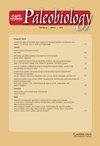体型变化的个体发生机制:对小人国效应及其他方面的启示
IF 2.6
2区 地球科学
Q2 BIODIVERSITY CONSERVATION
引用次数: 0
摘要
体型在古生物学中有着悠久的研究历史,它是宏观进化中许多重要现象的基础。化石记录中的体型模式通常仅通过使用体型数据来检验,这阻碍了我们描述宏观进化时间尺度上体型变化背后的生物学意义的能力。如果没有反映驱动尺寸变化的生物和地质因素的数据,我们就无法评估其机制基础。研究个体发育和系统发育的现有框架可以弥补这一问题,特别是经典的年龄-大小-“形状”空间,最初是为研究异时性而开发的。当根据年龄、体型和种群表型的指标进行评估时,体型变化的机制可以从理论上进行概述,并在记录中进行实证检验。利用这个框架,我们可以比较物种内部和物种之间的个体发生轨迹,并确定大小变化是如何出现的。在这里,我们概述了进化尺寸变化的个体发生机制,如异时性,以及地质因素如何驱动明显的非生物尺寸变化(如地层学尺寸分选)。为了证明这一框架在实际古生物问题中的实用性,我们将其应用于利力浦特效应,这是一种引人注目的、广泛记录的灭绝事件期间尺寸减小的模式。然而,人们对这种模式背后的机制知之甚少。我们提供了利力浦特效应的简史,并在一个可以进行机械测试的框架中完善其定义。可能产生利力浦特效应的过程包括异速生长和序列重组(包括异时性)以及进化大小选择排序。我们描述了这些机制,并强调了利力浦特效应的相关例子,其中可行的经验检验是可能的。本文章由计算机程序翻译,如有差异,请以英文原文为准。
Ontogenetic mechanisms of size change: implications for the Lilliput effect and beyond
Body size has a long history of study in paleobiology and underlies many important phenomena in macroevolution. Body-size patterns in the fossil record are often examined by utilizing size data alone, which hinders our ability to describe the biological meaning behind size change on macroevolutionary timescales. Without data reflecting the biological and geologic factors that drive size change, we cannot assess its mechanistic underpinnings. Existing frameworks for studying ontogeny and phylogeny can remedy this problem, particularly the classic age–size–“shape” space originally developed for studies of heterochrony. When evaluated based on metrics for age, size, and phenotype in populations, proposed mechanisms for size change can be outlined theoretically and tested empirically in the record. Using this framework, we can compare ontogenetic trajectories within and between species and determine how changes in size emerge. Here, we outline ontogenetic mechanisms for evolutionary size change, such as heterochrony, as well as how geologic factors can drive apparent, non-biological size change (e.g., taphonomic size sorting). To demonstrate the utility of this framework in actual paleobiological problems, we apply it to the Lilliput effect, a compelling and widely documented pattern of size decrease during extinction events. However, little is known about the mechanisms underlying this pattern. We provide a brief history of the Lilliput effect and refine its definition in a framework that can be mechanistically tested. Processes that likely produce Lilliput effects include allometric and sequence repatterning (including heterochrony) and evolutionary size-selective sorting. We describe these mechanisms and highlight relevant examples of the Lilliput effect for which feasible empirical tests are possible.
求助全文
通过发布文献求助,成功后即可免费获取论文全文。
去求助
来源期刊

Paleobiology
地学-古生物学
CiteScore
5.30
自引率
3.70%
发文量
38
审稿时长
>12 weeks
期刊介绍:
Paleobiology publishes original contributions of any length (but normally 10-50 manuscript pages) dealing with any aspect of biological paleontology. Emphasis is placed on biological or paleobiological processes and patterns, including macroevolution, extinction, diversification, speciation, functional morphology, bio-geography, phylogeny, paleoecology, molecular paleontology, taphonomy, natural selection and patterns of variation, abundance, and distribution in space and time, among others. Taxonomic papers are welcome if they have significant and broad applications. Papers concerning research on recent organisms and systems are appropriate if they are of particular interest to paleontologists. Papers should typically interest readers from more than one specialty. Proposals for symposium volumes should be discussed in advance with the editors.
 求助内容:
求助内容: 应助结果提醒方式:
应助结果提醒方式:


